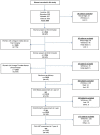Omega-3 Fatty Acid Intake during Pregnancy and Child Neuropsychological Development: A Multi-Centre Population-Based Birth Cohort Study in Spain
- PMID: 35276877
- PMCID: PMC8838693
- DOI: 10.3390/nu14030518
Omega-3 Fatty Acid Intake during Pregnancy and Child Neuropsychological Development: A Multi-Centre Population-Based Birth Cohort Study in Spain
Abstract
Background: There are few studies that look at the intake of all types of omega-3 polyunsaturated fatty acids (n-3 PUFAs) during the different stages of pregnancy along with a long-term neuropsychological follow-up of the child. This study aims to explore the association between maternal n-3 PUFA intake during two periods of pregnancy and the child’s neuropsychological scores at different ages. Methods: Prospective data were obtained for 2644 pregnant women recruited between 2004 and 2008 in population-based birth cohorts in Spain. Maternal n-3 PUFA intake during the first and third trimester of pregnancy was estimated using validated food frequency questionnaires. Child neuropsychological functions were assessed using Bayley Scales of Infant Development version one (BSID) at 1 year old, the McCarthy Scale of Children’s Abilities (MSCA) at 4 years old, and the Attention Network Test (ANT) at 7 years old. Data were analysed using multivariate linear regression models and adjusted for potential covariates, such as maternal social class, education, cohort location, alcohol consumption, smoking, breastfeeding duration, and energy intake. Results: Compared to participants in the lowest quartile (<1.262 g/day) of n-3 PUFA consumption during the first trimester, those in the highest quartile (>1.657 g/day) had a 2.26 points (95% confidence interval (CI): 0.41, 4.11) higher MSCA general cognitive score, a 2.48 points (95% CI: 0.53, 4.43) higher MSCA verbal score, and a 2.06 points (95% CI: 0.166, 3.95) higher MSCA executive function score, and a 11.52 milliseconds (95% CI: −22.95, −0.09) lower ANT hit reaction time standard error. In the third pregnancy trimester, the associations were weaker. Conclusions: Positive associations between n-3 PUFA intake during early pregnancy and child neuropsychological functions at 4 and 7 years of age were found, and further clinical research is needed to confirm these findings.
Keywords: children; maternal diet; neurodevelopment; omega-3 fatty acids; population-based cohort.
Conflict of interest statement
The authors have no conflict of interest relevant to this article to disclose.
Figures


References
-
- United Nations United Nations Sustainable Development Knowledge Platform. Sustainable Development Goals. 2015. [(accessed on 14 January 2020)]. Available online: https://sustainabledevelopment.un.org/?menu=1300.
-
- World Health Organization Global Targets 2025. [(accessed on 14 January 2020)]. Available online: https://www.who.int/nutrition/global-target-2025/en/
-
- World Health Organization . WHO Recommendations on Antenatal Care for a Positive Pregnancy Experience. WHO; Luxemburg: 2016. [(accessed on 6 January 2022)]. Available online: https://www.who.int/publications/i/item/9789241549912. - PubMed
-
- European Food Safety Panel on Dietetic Products, Nutrition, and Allergies Scientific Opinion on Dietary Reference Intakes for fats, including saturated fatty acids, polyunsaturated fatty acids, trans fatty acids, monounsaturated fatty acids, trans fats, and cholesterol. EFSA J. 2010;8:1–107.
-
- Food and Nutrition Board, Institute of Medicine Dietary Reference Intakes for Energy . Carbohydrate, Fiber, Fat, Fatty Acids, Cholesterol, Protein and Amino Acids (Macronutrients) The National Academies Press; Washington, DC, USA: 2005.
Publication types
MeSH terms
Substances
Grants and funding
LinkOut - more resources
Full Text Sources

